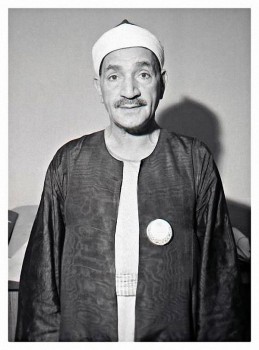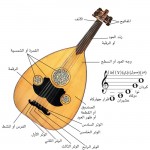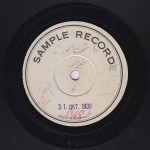The Arab Music Archiving and Research foundation (AMAR), in collaboration with the Sharjah Art Foundation (SAF), presents “Sama‘ ”.
“Sama‘ ” discusses our musical heritage through comparison and analysis…
A concept by Mustafa Said.
Dear listeners,
Welcome to a new episode of “Sama‘ ”.
Today, we will resume our discussion about tawshīḥ (improvised responsorial parareligious vocal form to a binary rhythm) “Mā shamamtu al-ward” written by Ḥasan bin ‘Abd al-Ṣamad al-Juba‘ī and composed by Sheikh Zakariyyā Aḥmad.
We mentioned that this tawshīḥ was first recorded by Odeon in the late 1920s, 1928 or 1929, in the voice of Sheikh Ibrāhīm al-Farrān, in our last episode that ended with the following tafrīd (improvisation)…
(♩)
Beautiful, Sheikh Ibrāhīm! What a great performance! As highlighted in our previous episode, he performed to two dīwān-s (octave) in one tafrīda until he reached the sikāh’s fundamental position.
We then explained that the tafrīd is different depending on the performer:
- Sheikh Ibrāhīm al-Farrān stopped ‘ala al-waḥda in the end;
- Sheikh Ṭāha al-Fashnī mostly did not as he broke the rhythm of the waḥda (binary periodic percussive module), his improvisation being mostly mursal (non-metrical), helped by the absence of a percussive instrument. In fact, the two recordings we have of him do not include any accompanying instruments;
- Wadī‘ al-Ṣāfī transformed the tawshīḥ that is originally a collective performance into a solo song like those he used to sing at the time.
Let us start again from the beginning with the tafrīd as there is always some confusion among musicians: Is tafrīd an improvisation or is it fully pre-planned? It is actually supposed to be both.
Unfortunately, the recording we have of Sheikh Ibrāhīm al-Farrān is a disc recording, and thus provides no information about his interpretation in live performances.
Still, it leads to the following deductions:
- On side one, Sheikh Ibrāhīm al-Farrān did not go outside the first musical phrase “Mā shamamtu al-ward”: he remained within it throughout the whole side. –Refer to the previous episode for confirmation;
- On side two, the music conveys an impression of a bayyātī at the seventh, i.e. a bayyātī / ḥusaynī (the maqām’s seventh). Sheikh Ibrāhīm al-Farrān started directly with “Lastu adrī mā lladhī qad ḥalla bī min muqlatēk”, which implies that he either did not lead the modulation vocally and they repeated “Mā shamamtu al-ward” then went directly to “Lastu adrī mā lladhī qad ḥalla bī min muqlatēk”, or that he did so in the live performance yet the turn of the disc replaced/was used for this transition. In my opinion, he most likely led the modulation vocally, the same as he –not the music– did later from “Lastu adrī mā lladhī” to “Rushiq al-qalbu bi-sahmin” …
(♩)
He also led the modulation from the sikāh in “Rushiq al-qalbu bi-sahmin qawsuhu min ḥāgibēk” to the rāst in “In yakun gismī tanā’a”…
(♩)
Only in the end do they go back to inshād (chanting) “In yakun gismī tanā’a” and the last verse, which is customary: the two phrases are chanted together in the end most of the time. They rarely only chant one phrase in the end… Mostly, the two phrases conclude in the end.
This was Sheikh Ibrāhīm al-Farrān’s plan.
Now, let us take a break with Sheikh Ṭāha al-Fashnī’s Radio recording of the full tawshīḥ added to some verses he performed as an ibtihāl (supplication. invocation. litany) after tawshīḥ “Mālik al-mulk fī yadayka qiyādī” that was itself a tawshīḥ composed twice, once to the jahārkāh and once to the bayyātī.
Let us listen to “Mā shamamtu al-ward” in the voice of Ṭāha al-Fashnī recorded in the 1960s …
(♩)
Beautiful calmness and experience! What a great voice! Sheikh Ṭāha al-Fashnī reaches a peak of experience and calmness, and continuous renewal.
Before we start with Ṭāha al-Fashnī’s plan, let us stop a little with Wadī‘ al-Ṣāfī who sang layālī (also called taqsīm yā lēl, musically improvised cantillation of the text in colloquial Egyptian « Yā lēlī ! yā ‘ēnī ! » [My night! My eyes!]) once, then again between “Mā shamamtu al-ward” and “Yā ḥabībī mā lladhī qad ḥalla bī min muqlatēk” where he replaced “Lastu adrī” with “Yā ḥabībī”, and improvised on the words “Yā ḥabībī”, like Muḥammad ‘Abd al-Wahāb in the record “Gafnuhu ‘allam al-ghazal”… I think that he stretched the words similarly when improvising in “Gafnuhu ‘allam al-ghazal” in his live performances.
Let us listen to “Yā ḥabībī” by Wadī‘ al-Ṣāfī. I think that some of the violinists recorded after he had finished recording: they added to his recording (multitrack) …
(♩)
When Wadī‘ al-Ṣāfī continues, there is a reverse-type counterpoint that was widespread in the 50s, 60s, and 70s’ popular music.
Let us listen to the verse he changed from “Lastu adrī” to “Yā ḥabībī mā lladhī qad ḥalla bī min muqlatēk” and “Rushiq al-qalbu bi-sahmin qawsuhu min ḥāgibēk” and note the qafla (conclusion) that he changed from a sikāh to a rāst for the purposes of his new tafrīd. He either decided to change it or had simply forgotten the old qafla. He had probably not listened to the tawshīḥ for a long time and forgot what he had memorised, and so concluded with the rāst instead of the sikāh… God knows.
Besides this, there are the points we mentioned earlier, such as the ascending and descending cross-interaction between him and the ensemble who later ascended with him then stopped at the same scale-step (reverse)… the vertical musāwaqa (responsive exchange) that was widespread in popular music during the second half of the 20th century, as we explained earlier.
Let us listen …
(♩)
Let us go back to Sheikh Ṭāha al-Fashnī’s plan:
In the previous recording –you can refer to it–, he started with “Mā shamamtu al-ward” then later went back to it. After this, he let the biṭāna continue until “In yakun gismī tanā’a, f-al-ḥasha bāqin ‘alēk”, i.e. they chanted “Mā shamamtu al-ward”, “Lastu adrī mā lladhī”, “Rushiq al-qalbu bi-sahmin”, and “In yakun gismī tanā’a” all in a sequence. Only the phrase “Inna dā’ī wa-dawā’ī” is missing as he later performed a tafrīd to the rāst on “In yakun gismī tanā’a, f-al-ḥasha bāqin ‘alēk”. Sheikh Ṭāha goes on relaying this phrase to them several times, sometimes to the rāst and sometimes improvising within the rhythm. For example, he once improvised on the dārij (Arabic word meaning: popular. common; it is a variant to the samā‘ī dārij cycle of the samā‘ī instrumental form, generally concluding the waṣla) rhythm: he changed the rhythm but kept the dārij rhythm (a 3 pulse’ rhythm instead of a 4 pulse’ rhythm) …
(♩)
He chanted “Inna dhātī wa-ṣifātī yā ḥabībī bēn yadēyk” and not “Inna dā’ī wa-dawā’ī” like the others. Beautiful!
Then, again in the conclusion, they chanted the two last phrases –the fourth and the fifth, i.e. “In yakun gismī tanā’a” and “Inna dā’ī wa-dawā’ī”– together. This is Ṭāha al-Fashnī’s plan, which does not necessarily imply that he did not improvise, because he did. Everything he chanted was improvised, created on the spot.
To illustrate this, let us end our episode with a beautiful recording made in the late 40s, 1950 at the latest, –anyway it was certainly made before August 1952– in Mūlid al-Mursī Abū ‘Abbās in Alexandria.
This tawshīḥ is performed within a beautiful waṣla (vocal and instrumental sequence of the Levan’t Arab urban tradition, following an improvised fixed pattern, based on one mode) by the Radio, that was broadcasted live. We thank Mr. Muḥsin Abū ‘Alā’ for giving us this recording.
While listening to it, note that it is in the open courtyard of the Mosque… of course, he is singing to the maqām of Mursī Abū ‘Abbās. There was apparently a praiser / eulogist, and a sullamiyya (popular instrument similar to a harp) whose sound is very clear in the background in Sheikh Ṭāha’s recording… There was a mūlid (or Mawlid: the celebration of the birth of the Prophet) with many things happening at the same time, added to the excellent old Ribbon microphones that recorded sound from afar and thus recorded this sullamiyya everyone will notice while listening. Those who do not must focus on the seventh minute of the recording… they will surely hear it.
We have reached the end of today’s episode of “Sama‘ ” about tawshīḥ “Mā shamamtu al-ward” written by Ḥasan bin ‘Abd al-Ṣamad al-Juba‘ī and composed by Sheikh Zakariyyā Aḥmad.
We will meet in a new episode of “Sama‘ ” to discuss and analyse another work.
Here is Sheikh Ṭah al-Fashnī in al-Mursī Abū ‘Abbās …
(♩)
“Sama‘ ” was presented to you by AMAR.
- 221 – Zakariyya Ahmed – 12 (1/9/2022)
- 220 – Zakariyya Ahmed – 11 (1/9/2022)
- 219 – Zakariyya Ahmed – 10 (11/25/2021)
- 218 – Zakariyya Ahmed – 9 (10/26/2021)
- 217 – Zakariyya Ahmed – 8 (9/24/2021)
- 216 – Zakariyya Ahmed – 7 (9/4/2021)
- 215 – Zakariyya Ahmed – 6 (8/28/2021)
- 214 – Zakariyya Ahmed – 5 (8/6/2021)
- 213 – Zakariyya Ahmed – 4 (6/26/2021)
- 212 – Zakariyya Ahmed – 3 (5/27/2021)
- 211 – Zakariyya Ahmed – 2 (5/1/2021)
- 210 – Zakariyya Ahmed – 1 (4/28/2021)
- 209 – W-al-Lāhi lā astaṭī‘u ṣaddak 2 (4/6/2017)
- 208 – W-al-Lāhi lā astaṭī‘u ṣaddak 1 (3/30/2017)
- 207 – Bashraf qarah baṭāq 7 (3/23/2017)




